#Aquaponic system
Text
Every once in a while i get the manic urge to start an aquaponic system. It gets so bad that i plan the whole thing and do the calculations every time and everytime, i get SO close to actually buying fish for this. And I know that I cannot realistically maintain all that and have to stop and chant to myself "i dont need this i dont need this i dont need this—" but the farmer inside of me is saying "dont you wanna eat fresh veggies AND fresh fish right from your backyard without needing to interact with people in the market. Think about it. You have everything you need to start an aquaponics system. All that is left is the fish and we LOVE fish—" now im clutching on my metaphorical pearls like NOOOO SHUTUPSHUTUP I DONT NEED THIS I DO NOT NEED A BACKYARD AQUAPONICS SYSTEM— and it dies for a bit until the mania starts again
#i think we should ALL get the manic urge to start a sustainable food source system#its what we deserve#i have calculated the costs of everything in this possible project and almost contacted the fish seller#i had to physically stop myself#This mania has been going on for years now btw#Im so normal about aquaponics I swear#I also almost started a quackaponics system. like. i literally already got ducks for it but i had to stop myself#because where tf would i put TWO whole ass ducks in my small backyard???#anyways i recovered early enough that I sold the ducks to a local farm#random blue rambles#aquaponics
25 notes
·
View notes
Text
I’m starting to put my final research paper together for grad school and I’m actually excited?
#I’m researching hydroponic systems and how they can combat areas in food insecurity#hydroponics/aquaponics is super interesting in itself#and I teach a unit on it every year anyway#but this is IT man#I’m almost DONE#I’ll be up to my eyeballs in work until December#but I’m enjoying the research I’m doing#flamey's personal crap
3 notes
·
View notes
Text
AQUAPONIC CUCUMBERS ~ NOT JUST FOR EATING
AQUAPONIC CUCUMBERS ~ NOT JUST FOR EATING
The lowly cucumber you say…not so and it can be grown quite well in an Aquaponic System.
The cucumber has many uses other than for placement in fresh salads or canning to create pickles.
Check out the list below:-
1. Cucumbers contain most of the vitamins you need Every day, just one cucumber contains Vitamin B1, Vitamin B2, Vitamin B3, Vitamin B5, Vitamin B6, Folic Acid, Vitamin C, Calcium,…
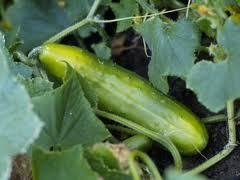
View On WordPress
#aquaponics#CANTELOPE#CUCUMBER#diy aquaponics#filtration media#fish#flood and drain#grow bed#grow bed media#hydroponics#magazine#off grid#PICKEL#raft system#sweet basil#tanks#Tilapia#vegetables#veggies#worm castings
3 notes
·
View notes
Text
#agribusiness#agriculture#hydroponics#guyana#lmsu#farming#aquaponics#self made system#black farmers#winton#aquagreens_guyana#tik tok
0 notes
Text
Smart Farms-Background,Principles,Advantages,Disadvantages,Applications,Outlook
Background
Smart farms are an innovative agricultural system that integrates information and communication technology with agriculture, aiming to enhance efficiency and productivity compared to traditional farming methods. The need to introduce new technologies and methods in agriculture has become increasingly urgent due to climate change and population growth, necessitating an increase in food production and improved efficiency in crop production.
Principles
Sensors and IoT Technology:
Smart farms utilize various sensors and IoT (Internet of Things) technology to monitor crop growth conditions, soil status, and weather information in real-time. This allows farmers to assess the health of their crops and take necessary actions.
Automation and Robotics:
Smart farms employ automation and robotics to automate farming tasks. Robots perform tasks such as planting, maintenance, and harvesting, while automated systems reduce labor demands and enhance productivity.
Big Data and Artificial Intelligence:
Smart farms use big data and artificial intelligence to predict crop yields and provide optimal growing conditions. This enables farmers to develop efficient production plans and improve crop quality.
Advantages
Increased Productivity:
Smart farms significantly boost productivity through automated and optimized cultivation management. Efficient farming systems reduce work time and increase crop yields.
Resource Conservation:
Smart farms efficiently manage resources such as water, fertilizer, and energy, minimizing waste. Through sensors and data analysis, farmers can predict the exact needs of crops and use resources efficiently.
Improved Quality:
Smart farms enhance crop quality through precise cultivation management and monitoring. By identifying the optimal harvest time and conditions, high-quality agricultural products can be produced.
Disadvantages
High Cost:
Establishing a smart farm requires expensive sensors, robots, and other equipment, leading to high initial investment costs. Maintenance and upgrade costs also need to be considered.
Dependence on Technology:
Smart farms rely heavily on the latest technology, necessitating the ability to adapt to technological changes. Rapid advancements in technology may render implemented systems obsolete quickly.
Applications
Precision Agriculture:
Smart farms offer optimal growing conditions by precisely monitoring crop growth, soil conditions, and weather. This enables farmers to observe crop growth in real-time and take necessary actions.
Automated Agriculture:
Smart farms automate farming tasks using robots and automated equipment. Robots perform tasks such as planting, maintenance, and harvesting, reducing labor demands and enhancing productivity.
Data-Driven Decision Making:
Smart farms use sensor data and big data analysis to predict crop yields and establish optimal production plans. This enables efficient production management for farmers.
Resource Management:
Smart farms efficiently manage resources such as water, fertilizer, and energy, minimizing waste. Through sensors and data analysis, farmers can predict resource usage accurately and allocate resources efficiently.
Outlook
Smart farms are bringing about innovative changes in the agricultural sector, contributing to increased efficiency in crop production and minimizing environmental impact. With the further development of sensor technology, big data analysis, and artificial intelligence, smart farms are expected to play a crucial role in leading the future of agriculture.
#poster#smart#smart farms#farms#automatics#Vertical farming#Precision agriculture#Hydroponics#Aquaponics#IoT in agriculture#Agricultural automation#Crop monitoring systems#Smart greenhouse
1 note
·
View note
Link
Aquaponics combines two growing methods, aquaculture and hydroponics, to create a self-contained, well-balanced ecosystem. Fish are fed and raised in a tank and as gravity pulls the wastewater through a hydroponic garden, bacteria feed on the waste, breaking it down into essential nutrients for the plants to grow. The system then returns the cleaned water back to the fish reservoir so the process can begin again. Get started with your own solar kit you can set up at home: https://amzn.to/3jNGmdI In this episode, Charles Collins shares his backyard aquaponic and hydroponic gardens where he's able to grow tilapia, leafy greens, peppers, herbs and so much more, all in the suburban desert. Together we grow! You can follow Charles here: https://youtube.com/channel/UCdU6O4JjaL_jXtie6GzKkow Podcast: https://youtu.be/_pTu2HvVPP4?si=StTF95d7zNSLMrKj LIKE, COMMENT, SUBSCRIBE, & SHARE! BEHIND THE SCENES: https://www.patreon.com/PARAGRAPHIC PRODUCTS & SERVICES: https://paragraphic.io/ AMAZON STOREFRONT: https://www.amazon.com/shop/paragraphic BOKEH SUPPLEMENTS: https://bokehrola.com/ JOIN THE MULTITUDE: https://www.multitude.io FOLLOW US @theparagraphic https://www.instagram.com/theparagraphic/ • • • • • • • • ABOUT PARAGRAPHIC: Handcrafted documentaries featuring artisans of all trades. We are filmmakers who tell the stories of creators, makers, entrepreneurs, and artists. The ones who have committed everything to their craft. From garage bakeries and mushroom farms to backyard aquaponics and innovative fabricators, these stories will take you behind the brand and show an inside look at the people who make it happen. -Of the earth, from the plough #aquaponics #hydroponics #aquaculture
#crosspost#Backyard Aquaponics Farming Fresh Fish and Vegetables | PARAGRAPHIC#PARAGRAPHIC#Aquaponics combines two growing methods#aquaculture and hydroponics#to create a self-contained#well-balanced ecosystem. Fish are fed and raised in a tank and as gravity pulls the wastewater through a hydroponic garden#bacteria feed on the waste#breaking it down into essential nutrients for the plants to grow. The system then returns the cleaned water back to the fish reservoir so t#Charles Collins shares his backyard aquaponic and hydroponic gardens where he's able to grow tilapia#leafy greens#peppers#herbs and so much more#all in the suburban desert. Together we grow!
You can follow Charles here: https://youtube.com/channel/UCdU6O4JjaL_jXtie6GzKkow
Podcast:#COMMENT#SUBSCRIBE#& SHARE!
BEHIND THE SCENES: https://www.patreon.com/PARAGRAPHIC
PRODUCTS & SERVICES: https://paragraphic.io/
AMAZON STOREFRONT: https://ww#makers#entrepreneurs#and artists. The ones who have committed everything to their craft. From garage bakeries and mushroom farms to backyard aquaponics and inno#these stories will take you behind the brand and show an inside look at the people who make it happen.
-Of the earth#from the plough
aquaponics hydroponics aquaculture#youtube#zapier#ivys queue#2023-12-28T03:49:38Z#aquaponics#hydroponics#aquaculture#self-contained ecosystem
1 note
·
View note
Text
Exploring the Revolutionary World of Aquaponic Farming
Have you ever imagined a farming system that combines fish farming and plant cultivation in a symbiotic relationship? Welcome to the revolutionary world of aquaponic farming! In this blog post, we will dive deep into the concept of aquaponics, uncover its benefits, and shed light on its potential to transform the way we produce food sustainably.
What is Aquaponic Farming?
Aquaponics is an…
View On WordPress
#Aquaculture#Aquaponic farming#Efficient farming#Fish farming#hydroponics#Plant cultivation#Recirculating system#sustainable farming#Sustainable food production#urban farming
0 notes
Text
Hydroponics Growing System Indoor Garden with Grow Light Herb Garden Kit Indoor Gardening System Aero Garden System Aquaponics Growing System Hydroponic Tower, White
Hydroponics Growing System Indoor Garden with Grow Light Herb Garden Kit Indoor Gardening System Aero Garden System Aquaponics Growing System Hydroponic Tower, White
Product Description & Features:
Faster Growth Than Traditional Soil Planting: Plants grown in hydroponic growing system often grow faster than those grown in soil, as they have direct access to the nutrients they need. With…

View On WordPress
#Aero#AeroGarden#Aquaponics#Garden#Gardening#Grow#Growing#Herb#Hydroponic#Hydroponic Growing System#Hydroponic Growing Systems#Hydroponics#Indoor#Kit.#Light#System#Tower#White#with
1 note
·
View note
Text
Aquaponics Supplier
If you are an aquaponic grower, on a regular basis you will need fish food, grow cubes, packaging supplies, propagation materials, natural pest control and replacement plant rafts. Look through the Aquaponics Growing Supplies that we offer.
0 notes
Text
The Budget-Friendly Guide to Starting Your Own Aquaponics DIY Farm: Understanding the Cost
The Budget-Friendly Guide to Starting Your Own Aquaponics DIY Farm: Understanding the Cost
Starting your own aquaponics DIY farm may seem like a daunting task, but with the right knowledge and resources, it can be a budget-friendly and sustainable way to grow your own food. Aquaponics is a combination of aquaculture (the farming of fish) and hydroponics (the growing of plants without soil). In this system, the waste produced by the fish is used as a fertilizer for the plants, and in…

View On WordPress
#Aquaponics#budget#cost#diy#farm#Farming#Fish#food#Greenhouse#Homegrown#Hydroponics#organic#sustainable#System#water
1 note
·
View note
Text
Aquaponics Water Cooling Systems
Summertime implies a great deal of fresh veggies and fruits right from your own garden.
More sunlight doesn't equal chilly water for your fish.
In this post, I'm going to reveal a couple of methods on how to cool the water in your aquaponics system.

Let's begin with mentioning some quick fixes:
Quick Fixes
Include shade netting
When the sun beats down on your fish tank it will get warmer quicker. Your plants may wilt too because of the heat. That's why adding a 30% and even 50% shade internet over your plants is an excellent concept. It will cool off the environment.
Having shade netting set up will limit the sun direct exposure to the grow media in the grow beds. Grow media like clay pebbles can be heat taking in and might cause the water to heat up quickly if exposed to sunlight.
Insulate the walls of your fish tank and grow beds.
Insulating walls (especially the fish tank) will considerably decrease the heating of the water. Insulating can be done by utilizing stiff insulation panels or straw bales. You can use the insulation once again in the winter season to prevent freezing temperature levels.
Add ice bottles in little systems
This method will require some careful tracking however is an excellent short term service to an increase in temperature level. While other steps require time like the insulation or shade netting, adding ice bottles into the water will rapidly lower the temperature level of the system.
This just works with small backyard systems. Do not use the ice bottles straight in the fish tank. If you can, put them in the sump.
Do not fill the bottle completely full, this will burst in the fridge. Leave the water a couple of inches from the top.
Design Modifications
Include a vaporize cooler in your greenhouse
By cooling off the air, you can minimize the temperature level of the water. This only operate in a greenhouse.
Utilize an underground loop to cool the water.
This idea uses geothermal cooling capability. The idea is that you utilize a pump to run the water through a tube 5 to 10 feet (1.5-3 meters) underground.
You can utilize this temperature level to run a tube in a ditch and pump it back to the fish tank or sump. Since it doesn't need to travel quickly through these tubes, the volume doesn't need to be big. You can utilize a split-flow from your existing pump or use a completely different loop.
Increase the overall water volume of your system
The more volume of water you have, the more resistant it is to temperature changes. It is useful to increase the volume of your aquaponics system. Deep water culture will have more stable temperatures than NFT since DWC has more volume of water.
youtube
0 notes
Text
I received a couple of asks about aquaponics after yesterday's post so I thought I'd show how I add a new plant to the aquaponics system, to get a better idea of how it works!
Step 1. Grow your plants from seed in seed trays like normal seedlings (pictured here, young green beans)

2. When it has well-developed roots, extract the seedling using a teaspoon or some kind of other thing

3. Rinse it a bit (that's just to avoid having too much dirt end up in the fish tank) (if it's a little it's fine, the filter will catch it)
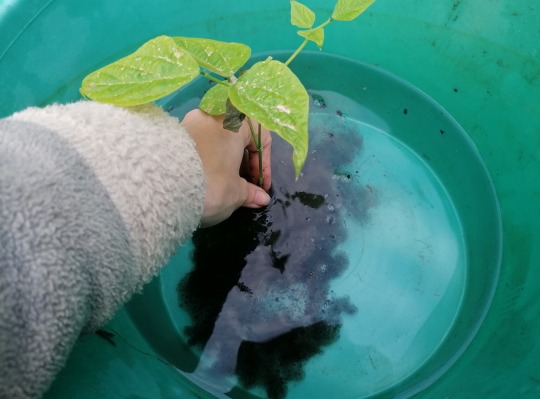
4. Let your dog carry out a routine inspection
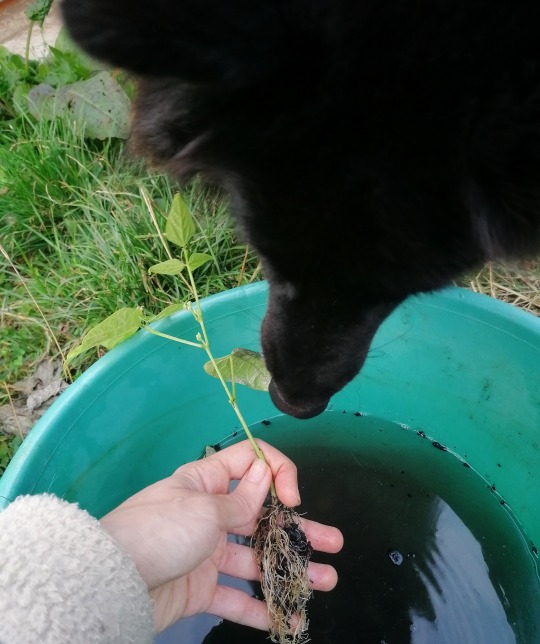
5. Wet a piece of cloth, which is just here to wick fish tank water and ensure the plants' roots are damp all the time. (5bis. Let your fish carry out a routine inspection)
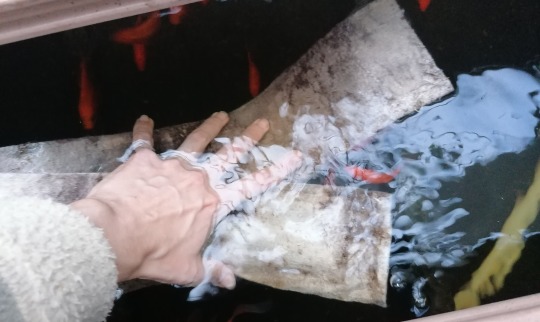
6. Place the seedlings on the cloth and the cloth sandwiched in the grow medium that'll go in the tower. It's a piece of foam and it's here so the plants' roots can hold on to it and not fall down as they grow vertically (you can see old dried roots from ghost beans still holding on to the foam)


7. Insert the foam into the tower like a little train of plants
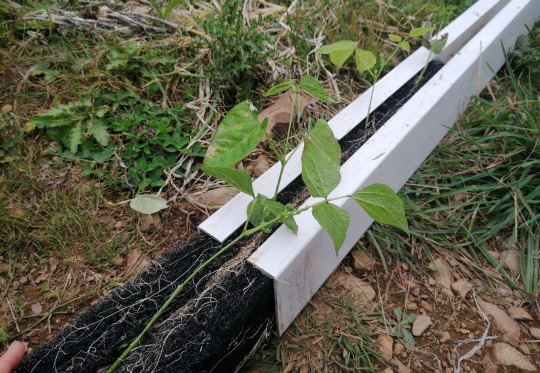
8. Hang the tower next to its friends
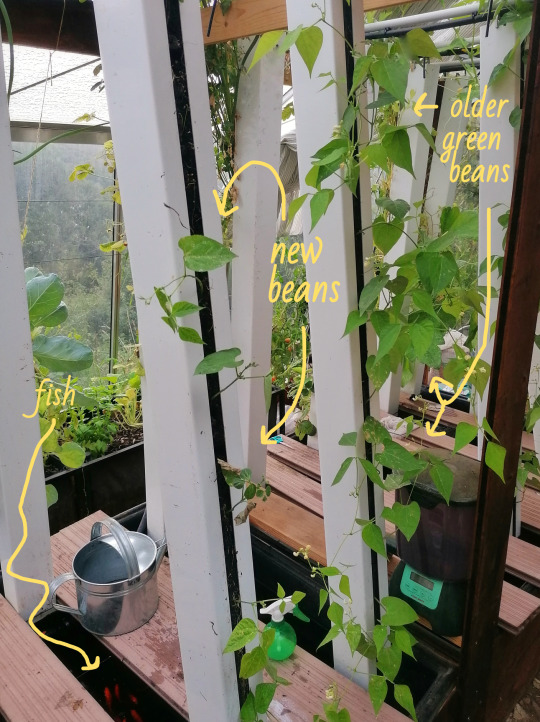

You can also grow seeds directly in little bits of growing medium, so then you just pop them in a free spot in a tower when they've sprouted, without having to take down the tower. I do this with plants that have tiny roots that would have trouble holding on to the cloth / foam on their own (here baby onions)


Some plants that are doing really well in the towers right now include pickles and strawberries! I've already pickled some pickles (2 jars) and am hoping for more. I'm not doing anything special with the strawberries because I just gobble them as soon as I can.

1K notes
·
View notes
Text
THE LOWLY SCUD
Finger food
The Scud is a freshwater shrimp and it is one of the most popular natural food sources for many fish, large and small. The Scud can reproduce several times a year and the female is able to carry about fifty fertilized eggs in her egg pouch. The eggs are orange in color and can be clearly seen beneath her transparent shell. Young scuds hatch within the pouch and emerge fully formed,…

View On WordPress
#aquaponics#Custaceans#diy aquaponics#filters#filtration media#fish#flood and drain#grow bed#grow bed media#magazine#media#off grid#raft system#Scuds#tanks#Tilapia#vegetables#veggies
2 notes
·
View notes
Text
#aquaponics#guyana#winton#self made system#process#lmsu#black farmers#hydroponics#aquagreens_guyana#tik tok
0 notes
Note
a friend of mine said that the environment would be better if everyone lived in cities and basically left the rest of the natural world alone... i felt like there was something wrong with that argument but i really dont know enough about it to have a real point against it. i might be biased though cause i love being around nature and want to be able to live rural without killing the environment? idk im just wondering if she's right and how to live in a way that isnt negatively impacting the world
love your blog btw, it's been the thing that's helped me understand ecology for once
the idea that humans Are Bad for the ecosystem—not that particular activities or practices have particular negative effects, that just humans existing harms the environment—is in fact the worst idea ever
I mean, first of all, where does your friend think food comes from?
"Food" is one of the problems. It's one of a lot of problems. Some other problems include "all other natural resources besides food" and "human rights."
It's not just your friend, this kind of thing has been suggested in varying ways by self identified "leftists" a bunch of times, and I genuinely hope they're mostly random laypeople who can't really be expected to know more than they can learn from being terminally addicted to Twitter, because otherwise I will call them "dumber than a sack of hammers" in those exact words.
No offense to your friend. Your friend is a laypeople. And sadly, non-experts end up with ass-backwards ideas about how conserving the environment works, because of all this commonplace nonsense about humans being a cancer upon the planet. I'm not angry about those people, just sad.
But my serious answer is—The world's most intact and best managed ecosystems are found on land owned and managed by Indigenous people, who do what with the land?
LIVE ON IT.
And these groups of people learned to manage and care for the land how?
BY LIVING ON IT.
Conventional (white, Western) intuition holds that human management of an ecosystem should reduce biodiversity, but what science shows—I mean what study and observation and data and more study and more observation and more data shows—is that indigenous land management practices can do better than Nature can on her own.
I mean, for one thing, if you don't live in a place, you don't observe it every day. You don't see how the ecosystem and its inhabitants change over time. You can't learn about it, and therefore you don't know about it.
Disconnection from nature is ignorance about nature and ultimately apathy towards nature, and that's the worst and most disrespectful thing we can do.
And like I hope it's clear that even in the imaginary scenario where everyone lives in a city, even if this was possible (it's not), the city dwellers who are separate from nature are living a silly little lie. You're part of the ecosystem. Don't like it? Go become a rock in space.
The electrical signals moving through your brain right now are rays of sunlight that were soaked up by a plant that grew in dirt. Do you know fruit? Do you enjoy fruit? I enjoy fruit, I'm drinking a smoothie right now! That fruit y'all love so much was pollinated by a bug.
A bug did that for you! Because you're family! Because you're part of this world, because you belong to this intricate and ancient community of living things that need each other, that were shaped by evolution to need each other, and nature cannot abandon you.
But more on the cynical side of things, even if you don't know where the hell a berry grows or how, someone has to grow and harvest and ship that berry to you, someone who has to live somewhere, and you should care who is doing it and how they're being treated and paid, and ultimately you should want for them the same things you want for you.
Urban life is just rural life with extra steps my friend.
Like, @ all the "put everybody in cities" crowd, what is the plan here? Fancy ass indoor aquaponics systems notwithstanding, we're not technologically at a point where we can just, like, build giant multi-story factory buildings where we grow food under special lamps, and even being at that point wouldn't make it a good idea. With all the hype about solar power, you'd think people would look at plants (have been using solar power just fine for like a billion years) and think, "Neat how those things can just make food when you stick 'em in the sunshine."
I'm sorry, I'm never going to be psyched about technological innovations that are like "We took a plant and put it inside."
There is so much I could say here. The brainrot in the wake of "cottagecore" discourse where a bunch of well meaning white people got convinced that farming was racist. The idea that rural people are somehow more complicit in colonialism than urban people, and that rural land is, I don't know, landier than urban land, and the correct and moral thing to do if you live on stolen land is to....what? Live on land that has a protective layer of concrete in between it and your racist feet?
Land ownership is a whole fucked up beast, but you're not cultivating a non-exploitative relationship with land by living in a city. There's just extra steps in between you and the land.
"Homesteading" as seen on cottagecore boards on Pinterest has a lot of white supremacist wet dream mixed in, but listen: It is not only okay, but GOOD, to want to live in close relationship with the land, with the food you eat, with the trees and plants that fill your lungs when you inhale. It's IMPORTANT. It's VITAL.
What has to change is that this relationship can't be based on ownership and dominance. Ecosystem is community and that ain't it.
My ancestors were colonizers, the land I live on right now was violently stolen, the ecosystem that once was very carefully managed so that it flourished with life was ravaged, and I don't even know the names of most of the life-forms that ought to be here. What now?
You belong to the ecosystem that takes care of you. You can't wash your hands of this and run away.
I feel like I'm getting off topic, but it's very much on topic actually. What I hope for the future is that we would stop entertaining the silly little lies that imagine we can just...opt out of participation in something that is underneath our every footstep and in our every breath. It would make us feel pure, but it wouldn't be real.
I do think that forcing people off the land that is their home is bad, in general. I don't think those people have to be indigenous for this to be bad—and successfully claiming otherwise is a bit of conundrum, since as far as I know, the political and social phenomenon of indigenous identity has a lot to do with the being forced off your land thing.
Obviously people like me don't have the same deeply central cultural relationship to the land, but the "we should all just go live in cities and leave nature to itself" proposal implies that such relationships are unnecessary or even bad.
I've said this before but I find it weird when environmentalists accommodate indigenous ways of life in their visions of the ideal future as like...a special exception granted because it's like, the nice thing to do for a historically marginalized and violently oppressed group. Not because there is value or merit in those ways of life. Like "Oh I guess indigenous people should be allowed to hunt because it's part of their culture" ????? And it's part of their culture because...why?
Maybe because it's a sustainable way of doing things and has been for millennia???
Like don't listen to me, look at the research, indigenous folks participating in ecosystems and managing them worldwide know what they're doing and the rest of the world should be looking to them as examples. Key word here is participating, because you can't competently manage an ecosystem with your head all the way up your ass with the idea that you're somehow not part of it.
Humans aren't a cancer upon the planet. It's capitalism and colonialism. It's the practice of seeing the world as a disposable resource to be exploited.
Humans lived in the place I called home for 15,000 years. Within the past 200 years, almost every forest was razed to the ground, and almost every large animal extirpated or damn near to it.
"Humans" did that! These humans are so terrible!
But I have to remember.
There are descriptions of this place from before that, and they describe a lush, teeming heaven-like paradise that the adjectives provided by English trembled to capture, so perfect and bountiful that the observers assumed this land was never tainted by Adam's sin.
Humans did that, too.
512 notes
·
View notes
Note
geolings are so cool, do you have anymore info about them you’d be willing to share? i’m especially curious about their home planet, tech, and diets
thank you!!! and sure! their tech stuff I have to do more thinking on (but they are advanced enough to currently be in a big space exploration era within their own solar system. one day I'll draw their aerospace stuff) however the other two I can share an alright chunk of info about
I do not have a map YET (I'm bad at those)(and need to research stuff) so I will give my best description of this instead: the Geoling Homeplanet is a super-earth orbiting a K-type star with red to purplish-red vegetation color and large amounts of ocean coverage. meanwhile geolings themselves are from a clade that evolved to occupy the sort of niche that semi-aquatic and marine mammals did, however all their closest relatives are smaller than them due to geolings exhibiting island gigantism. they are originally from the Wyu'hlkee island chain, a swath of land containing a massive trailing arc of volcanic islands, and three large main islands that connect to Ipsagaarin, a huge landmass that makes up their southern pole. a good amount of them still live in these areas to this day, but they have since traveled out to and expanded their presence into the other parts of the world.
in addition to this they have three moons, Waaraas, Waabors, and Ynsi. The first two are sometimes called (in approximate terms)"the twins" and actually have some life on them, but Ynsi is rather small and bare.
there is also an elevated amount of volcanism present on their homeplanet for no real reason other than I think it's fun :-) I like volcanos. though it's also because volcanic sand is the reason why geolings are originally very dark colored, but hopefully I can show off some of the much lighter variants soon.
As for their diet, they are Mesocarnivores and their teeth that you can see here are made more for crushing and slicing rather than grinding. ->

their diet mostly consists of fish, other large marine animals, shellfish (their fav food group), bones, fungi, fruit, and roots. they do use agricultural systems like underwater orchards, mushroom beds, and aquaponic farms to get their food now, but hunting for a meal isn't something that has vanished from everyday life for them. they use those funny whiskers you can see on them- those are actually sensory organs they use to find food underwater, primarily animals that are buried in sand. like this.

they have poor close range vision so they use their whiskers to sweep sandbeds and beaches for hidden snacks then dig them out with their teeth or handheld rakes. they can easily crack open shells and scrape meat out too. this is just a basic form of eating raw food, but they do love to cook too! frying foods in flavorful oil and fat, dousing them in spices, fungi shavings, and sprinkling them with salt is one of their favorite things to do. they're also huge fans of pickling and smoking food for preservation and flavor too. however they cannot taste sweets and the fruits they do eat are rather bitter or spicy.
thanks so much for asking :-) I love talking about them but most of my rambling about them is contained to discord servers and dms yet, since I don't like posting anything big about them if I don't have art to go with it. as much as I'd love to post essay length rants about specific topics I don't think many people would read them haha
#geolings#again I love talking about them so if you are curious about anything else feel free to ask. I will babble about it#spec bio#speculative biology
85 notes
·
View notes